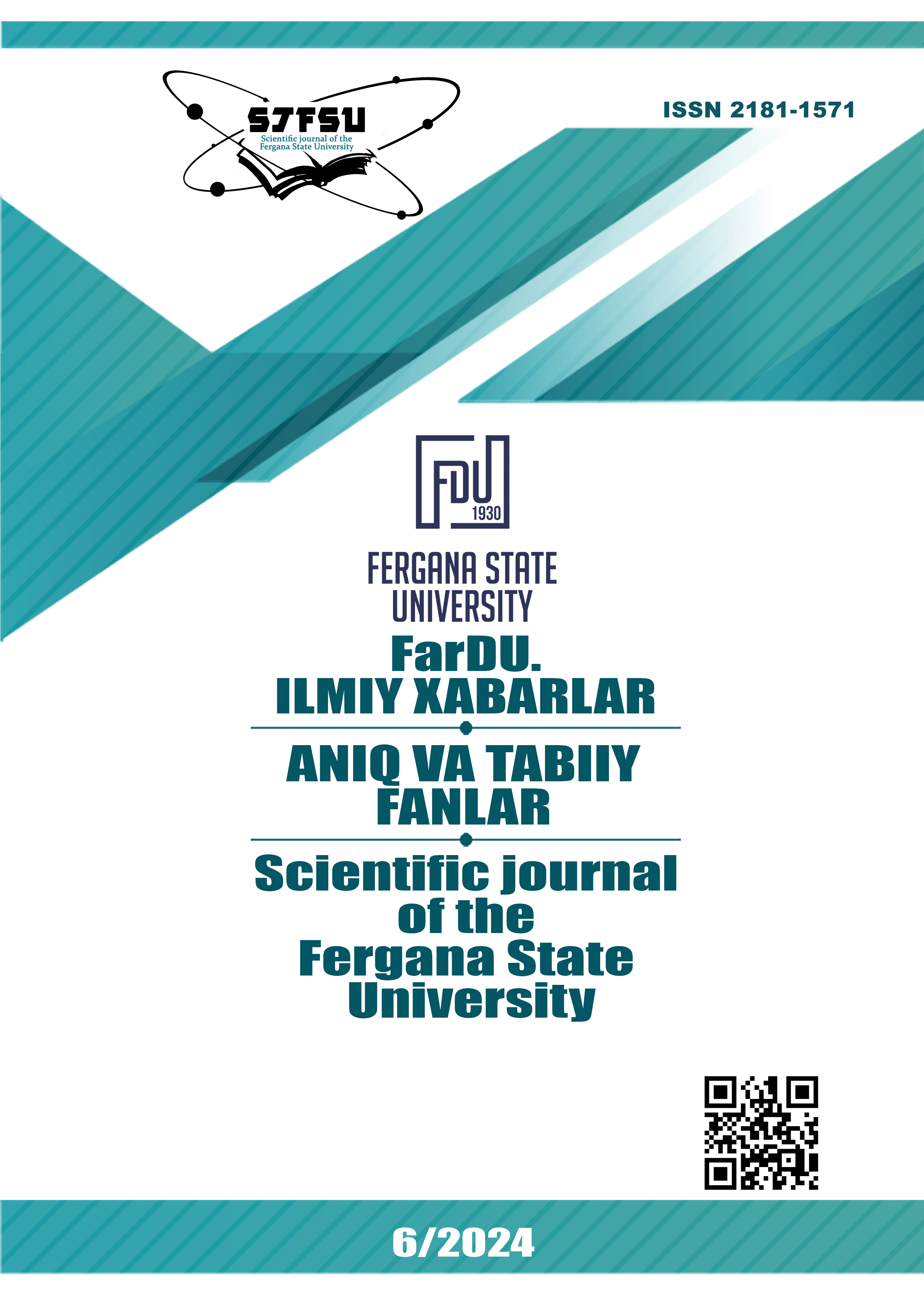METHODS FOR ASSESSING THE REPRESENTATIVENESS AND EFFECTIVENESS OF PROTECTED NATURAL AREAS SYSTEM
Keywords:
protected natural areas, representativeness, biological diversity, sustainable development, optimization, ecosystem, geoecology.Abstract
This article discusses the methods for evaluating the effectiveness of protected natural areas in nature conservation. To ensure the effectiveness of the territorial system of nature protection, it is necessary to conduct comprehensive research on the current state of the existing system of protected natural areas. In assessing the degree of landscape diversity within the system of protected natural areas, we utilize the Landscape Representativeness Index (LRI). This approach takes into account indicators such as the ecological status of landscapes, their share in the total area of the region, their proportion within the system of protected natural areas, the level of uniqueness, and the recommended minimum share for the establishment of protected natural areas. Such assessments are crucial for creating a regional level of representativeness within the system of protected natural areas.
References
UNEP, 2021. World met target for protected area coverage on land, but quality must improve, viewed 4 August 2021. https://www.unep.org/news-and-stories/press-r elease/world-met-target-protected-area-coverage-land-quality-must-improve.
UNEP-WCMC, IUCN, 2021. Protected Planet Report 2020, United Nations Environment Programme World Conservation Monitoring Centre & International Union for Conservation of Nature and Natural Resources, Cambridge, UK. Gland, Switzerland.
Стишов М.С., Дадли Н. Охраняемые природные территории Российской Федерации и их категории. –М.: Всемирный фонд дикой природы (WWF). 2018. -248 с.
Haojie Chen, Tong Zhang, Robert Costanza, Ida Kubiszewski. Review of the approaches for assessing protected areas’ effectiveness. Environmental Impact Assessment Review 98 (2023) 106929. pp. 1–11.
Sustainable Development Indicators. Departament for Environmen Food andRural Affairs (Defra). 2013. – 100 p.
Olson D.M. Terrestrial ecoregions of the world: a new map of life on Earth /D.M.Olson, E.Dinerstein, E.D.Wikramanayake [et al.] // Bioscience. 2001. Vol.51, № 11. -P. 933-938.
Аитов И.С. Геоэкологический анализ для регионального планирования и системной экспертизы территории (на примере Нижневартовского региона): Дисс. … канд. геогр. наук / – Нижневартовск, 2006. –179 с.
Forman R. T. T. Landscape ecology / R. T. T. Forman, M. Gordon. – N.Y. : John Wiley Sous, 1986. – 332 p.
Abdugʻaniyev O.I. Muhofaza etiladigan tabiiy hududlar tizimini takomillashtirish va ulardan foydalanishning geoekologik asoslari (Farg’ona vodiysi misolida). Monorafiya. Fargʻona, 2024-y. 296 b.
Чернова, О.В. Оценка репрезентативности сети особо охраняемых природных территорий России с точки зрения сохранения разнообразия естественных почв [Электронный ресурс] / О.В.Чернова // Электронное научное издание Альманах Пространство и Время. –2016. – Т. 11.
Соколов А.С. Количественная оценка ландшафтной репрезентативности охраняемых природных территорий регионов // Псковский регионологический журнал. – 2021. – Том 17. –№4 . –2021. –C. 123-137.
Рекомендации по расширению системы охраняемых природных территорий в Узбекистане / Отв. ред. А.Т.Исматов; Программа развития ООН в Узбекистане, Министерство сельского и водного хозяйства, Главное управление лесного хозяйства, ГЭФ. - Ташкент: Baktria press, 2013. - 256 с.
Токарчук С.М. Геоэкологическая оценка природоохранного потенциала административных районов Беларуси (как один из методов оценки репрезентативности сети особо охраняемых природных территорий) // Псковский регионологический журнал. – 2016. No 3 (27). -С. 31-45.
Theobald, D. M., Keeley, A. T. H., Laur, A., & Tabor, G. (2022). A simple and practical measure of the connectivity of protected area networks: The ProNet metric. Conservation Science and Practice, 4(11), e12823.
https://doi.org/10.1111/csp2.12823.
Xinyue Fan, Weihua Xu, Zhenhua Zang, Zhiyun Ouyang. Representativeness of China’s Protected Areas in Conserving Its Diverse Terrestrial Ecosystems. Ecosyst Health Sustain. 2023;9:0029.DOI: 10.34133/ehs.0029.
Geldmann J. Evaluating the effectiveness of protected areas for maintaining biodiversity, securing habitats, and reducing threats. PhD thesis. Copenhagen, Denmark, August 2013. P. 179.
Graeme S. Cumming, Craig R. Allen. Protected areas as social-ecological systems: perspectives from resilience and social-ecological systems theory. Ecological Applications, 27(6), 2017, pp. 1709–1717.
Miklós L. et al., Ecological Networks and Territorial Systems of Ecological Stability. © Springer International Publishing AG, part of Springer Nature, 2019. P. 152. https://doi.org/10.1007/978-3-319-94018-2.
Downloads
Published
Issue
Section
License
Copyright (c) 2025 Scientific journal of the Fergana State University

This work is licensed under a Creative Commons Attribution-NonCommercial-NoDerivatives 4.0 International License.
Most read articles by the same author(s)
- , , TIVENESS AND EFFICIENCY OF THE SYSTEM OF PROTECTED NATURAL AREAS , Scientific journal of the Fergana State University: No. 3 (2023): FarDU ilmiy xabarlari jurnali (Aniq va tabiiy fanlar)
- , , CULTURAL LANDSCAPE: GENERAL IDEAS AND CONCEPTS, RESEARCH APPROACHES , Scientific journal of the Fergana State University: No. 6 (2023): FarDU.Ilmiy xabarlar jurnali (Aniq va tabiiy fanlar)
- , , , ASSESSMENT OF REPRESENTATIVENESS AND EFFECTIVENESS OF THE SYSTEM OF PROTECTED NATURAL AREAS , Scientific journal of the Fergana State University: No. 1 (2024): FarDU ilmiy xabarlar jurnali ilova to‘plam (GEOGRAFIYA)
- , , ECOLOGICAL AND GEOGRAPHICAL ASPECTS OF PROTECTION KEY ORNITHOLOGICAL TERRITORIES , Scientific journal of the Fergana State University: No. 1 (2024): FarDU ilmiy xabarlar jurnali ilova to‘plam (GEOGRAFIYA)
- , , , BASICS OF GEOECOLOGICAL REGULATION OF LAND MANAGEMENT WORK , Scientific journal of the Fergana State University: No. 1 (2024): FarDU ilmiy xabarlar jurnali ilova to‘plam (GEOGRAFIYA)
- , , NATURAL DIVERSITY: THEORETICAL FOUNDATIONS, APPROACHES AND STUDY METHODS , Scientific journal of the Fergana State University: No. 3 (2023): FarDU ilmiy xabarlari jurnali (Aniq va tabiiy fanlar)
- Abdug‘aniev Olimjon Isomiddinovich, Abdullaeva Khamida, AGROTOURISM AS A FACTOR OF SUSTAINABLE RURAL DEVELOPMENT , Scientific journal of the Fergana State University: No. 3 (2024): FarDU.Ilmiy xabarlar jurnali. Ilova to'plam (Aniq va tabiiy fanlar)
- , , ECOLOGICAL AND GEOGRAPHICAL BASIS FOR THE ORGANIZATION OF TRANSBOUNDARY PROTECTED NATURAL AREAS , Scientific journal of the Fergana State University: No. 3 (2024): FarDU.Ilmiy xabarlar jurnali. Ilova to'plam (Aniq va tabiiy fanlar)
- , CARTOGRAPHIC IDEALIZATION OF THE EARTH'S SURFACE AND ITS ROLE IN RELIEF STRUCTURE STUDY , Scientific journal of the Fergana State University: No. 4 (2024): FarDU.Ilmiy xabarlar jurnali (Aniq va tabiiy fanlar)
- , BASIN STRUCTURE OF RELIEF IN COLLECTOR GEOSYSTEMS , Scientific journal of the Fergana State University: No. 4 (2024): FarDU.Ilmiy xabarlar jurnali (Aniq va tabiiy fanlar)

